Spies and Intelligence Services
Surveillance Underwear
The Intelligence Advanced Research Projects Activity (IARPA) recently announced that it's launching a program to develop "durable, ready-to-wear clothing that can record audio, video, and geolocation data." This will include underwear.The surveillance clothing will aim to be "stretchable, bendable, comfortable, and washable like regular clothing."
I'd like to see James Bond wearing surveillance underwear in his next movie.
More info: The Intercept; IARPA's press release
Posted By: Alex - Sat Sep 16, 2023 -
Comments (5)
Category: Spies and Intelligence Services, Underwear
Miss KGB and Miss Gulag
Some oddball beauty titles from Russia.In 1990, 23-year-old Katya Mayorova was crowned 'Miss KGB'. It was part of an effort to put a softer face on the intelligence service. It doesn't seem that there was a competition to select the winner. Mayorova was simply selected by a secret process. As far as I know, she was the only one to ever hold the title.
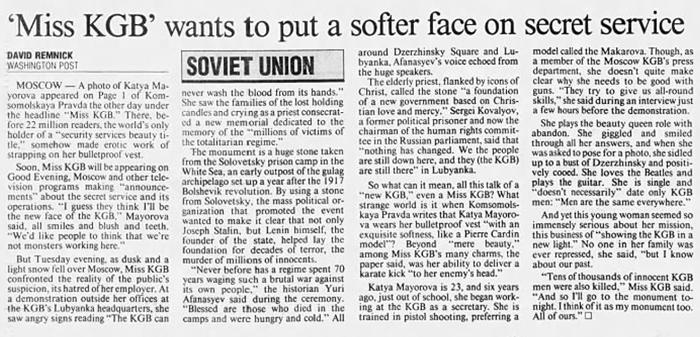
The Montreal Gazette - Nov 4, 1990
click to enlarge
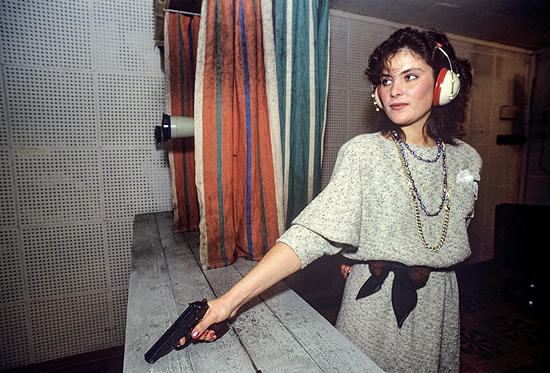

You can find more info about Miss KGB at Russia Beyond.
And from a totally different part of the Russian security apparatus, many women's prisons in Russia now hold beauty pageants. The winners aren't called 'Miss Gulag,' but that was the title of a documentary about the pageants. More info from Jean Trounstine, "Beauty Pageants in Prison Can Have Positive Effects," in At Issue: Beauty Pageants (2010).
As a woman who grew up in the sixties, I used to consider endorsing any sort of beauty contest inconceivable—but that was before I saw two short documentaries about the pageants at Camp UF-91/9, The Contest, produced by the Polish journalist Zygmunt Dzieciolowski, and Miss Gulag, produced by Neihausen-Yatskova and Vodar Films. They show the contenders taking the runway by storm, cheered on by their peers, in a parody of the stale rigidity and lack of sexuality of traditional pageants. . .
Beauty pageants are now widespread in Russian prisons. Make up, gifts for the unit, and credits toward early release are the prizes.
The Contest documentary: part 1, part 2, part 3
Posted By: Alex - Wed Aug 10, 2022 -
Comments (1)
Category: Awards, Prizes, Competitions and Contests, Prisons, Spies and Intelligence Services, Russia
Smelling the Enemy: The Odortype Detection Program
The U.S. Defense Advanced Research Projects Agency (DARPA) launched the "Odortype Detection Program" in 2002. It had two goals:The goal of Phase 2 will be to build a detector that can reliably detect the signature identified in phase 1 with high sensitivity and specificity.
By 2007, DARPA had changed the name of the program to the "Unique Signature Detection Program," but its goals remained essentially the same:
I haven't been able to find out what's become of the program since 2007. Though I'd wager that the U.S. government hasn't completely abandoned the idea since being able to identify people by their smell would be a hard-to-defeat surveillance technology. (Assuming that we all really do have a unique 'odortype' that can't be camouflaged with fragrance or by eating stinky food).
However, I did find a report on the program from 2005 that included the interesting detail that they field-tested the technology on seven sets of twins at Williamsburg, VA and Research Triangle Park, NC:
Posted By: Alex - Sun Jun 12, 2022 -
Comments (1)
Category: Military, Spies and Intelligence Services, Smells and Odors
Miss Cloak and Dagger
Aug 1957: Pat Strasser was awarded the title of Miss Cloak and Dagger at the National Counter Intelligence Corps Association's 10th annual convention.Miss Strasser, who is 5 feet 6 inches tall and weighs 118 in a bathing suit, was judged along with nine other finalists by a unique system that considered only one part of her shapely anatomy at a time.
First the 1,000 delegates scored the girls on legs, while the rest of their bodies were hidden. They worked their way up from there and the score cards were fed into the IBM machine.
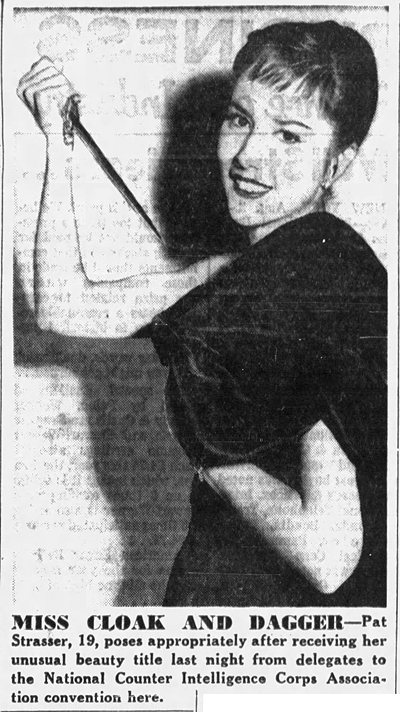
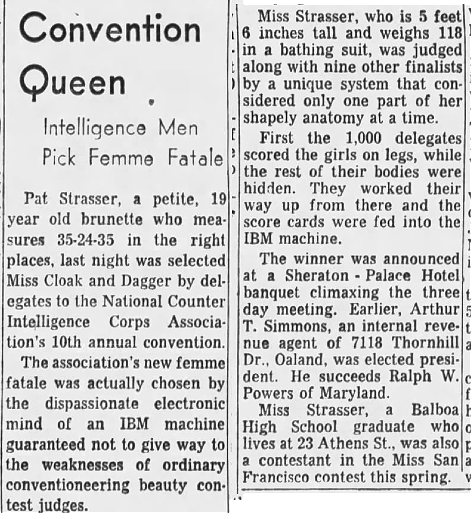
San Francisco Examiner - Aug 4, 1957
Posted By: Alex - Sun Mar 27, 2022 -
Comments (0)
Category: Awards, Prizes, Competitions and Contests, Spies and Intelligence Services, 1950s
Out of Sight
The Wikipedia page.
Posted By: Paul - Fri Sep 03, 2021 -
Comments (1)
Category: Fey, Twee, Whimsical, Naive and Sadsack, Humor, Ineptness, Crudity, Talentlessness, Kitsch, and Bad Art, Movies, Spies and Intelligence Services, Bohemians, Beatniks, Hippies and Slackers
Ice Pick Lobotomies
An ice pick lobotomy involves inserting an ice pick above the eyeball and hammering it into the brain to destroy the frontal lobes. In 1977, the CIA admitted that it had considered doing this to enemy agents as a way to erase their memory following interrogation. This secret program was code-named "Project Artichoke".However, the agency insisted that by 1972 it had abandoned the idea as too barbaric, and too likely to "invite horrible reprisals".
Some other interrogation techniques that the agency had considered, but rejected, included:
—Shining flickering lights at a prisoner. "The analyst ... mentioned watching a restaurant fan which was too slow, but nevertheless spoiled his appetite."
—Injecting forms of cocaine into a suspect's brain through holes in the skull. "Too surgical for our use."
—Odors were also considered. The documents said that terror has been produced by exposing a subject to a harmless odor, such as geranium, simulating the smell of a lethal gas.
More info: cia.gov


Sacramento Bee - Oct 30, 1977
Posted By: Alex - Thu May 27, 2021 -
Comments (2)
Category: Spies and Intelligence Services, 1970s, Brain Damage
Operation Cornflakes
1945: Toward the end of World War II, the American OSS cooked up a scheme to use postage stamps to demoralize the German people. The idea was to create fake 12 Pfennig stamps on which Hitler's profile was replaced by an image of Hitler with his jaw eaten away.The Operation had no discernible effect on German morale. But it's a favorite topic among stamp collectors, who are flattered to think that anyone in the OSS ever imagined that stamps might have had such an effect.
More info: wikipedia
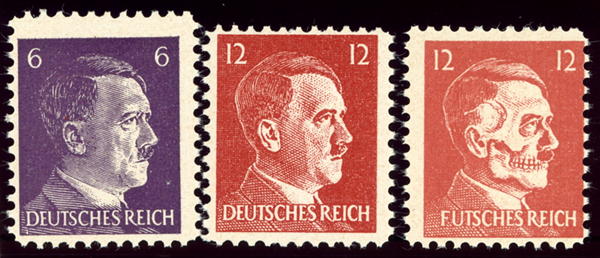
Posted By: Alex - Wed Feb 10, 2021 -
Comments (1)
Category: War, Spies and Intelligence Services, 1940s, Stamps
Avakoum Zahov, the Soviet James Bond
Avakoum Zahov was a fictional secret agent who featured in the novels of the Bulgarian writer Andrei Gulyashki. Zahov made his first appearance in the 1959 novel The Zakhov Mission. He returned in the 1966 novel Avakoum Zahov versus 07 — in which he battles and defeats a British agent known as '07'.
image source: pulp curry
There have been persistent rumors that Gulyashki created Zahov at the behest of the KGB in an attempt to produce a Soviet James Bond. Details from an article by Andrew Nette:
It is not clear where McCormick got his information, but others have since picked up the claim and run with it. The Penguin Dictionary of Literary Terms and Literary Theory states that Gulyashki ‘was invited by the KGB to refurbish the image of Soviet espionage which had been tarnished by the success of James Bond’. Likewise, Wesley Britton claims in Beyond Bond: Spies in Fiction and Film that, in 1966, the Bulgarian novelist was hired by the Soviet press to create a communist agent to stand against the British spy ‘because of Russian fears that 007 was in fact an effective propaganda tool for the West’.
"My name is Zahov, Avakoum Zahov" just doesn't have the same ring as "Bond, James Bond".
Posted By: Alex - Sat Feb 06, 2021 -
Comments (4)
Category: Literature, Books, Spies and Intelligence Services, 1960s
Caccolube
Or, how to ruin an engine, courtesy of the OSS."When circulated through this system, the compound fuses and welds the moving metal parts of the machinery. Slipped into a truck, the Caccolube takes effect after the truck has been driven from 30 to 50 miles. It reacts so thoroughly on pistons, cylinder walls and bearing journals that the vehicle is not only thrown out of service but the engine is destroyed beyond repair."
This lethal "lube job" replaced the original effort using sugar, when it was discovered that sugar actually promoted better engine performance in the vehicles of that era.
Source: Jack Anderson, "Rare arsenal used by spies," Santa Cruz Sentinel, Mar 9, 1987.
Posted By: Alex - Sat Sep 12, 2020 -
Comments (1)
Category: Motor Vehicles, War, Weapons, Spies and Intelligence Services
Private Snafu in “Spies”
Posted By: Paul - Sun Mar 08, 2020 -
Comments (1)
Category: Spies and Intelligence Services, 1940s

| Who We Are |
|---|
| Alex Boese Alex is the creator and curator of the Museum of Hoaxes. He's also the author of various weird, non-fiction, science-themed books such as Elephants on Acid and Psychedelic Apes. Paul Di Filippo Paul has been paid to put weird ideas into fictional form for over thirty years, in his career as a noted science fiction writer. He has recently begun blogging on many curious topics with three fellow writers at The Inferior 4+1. Contact Us |




